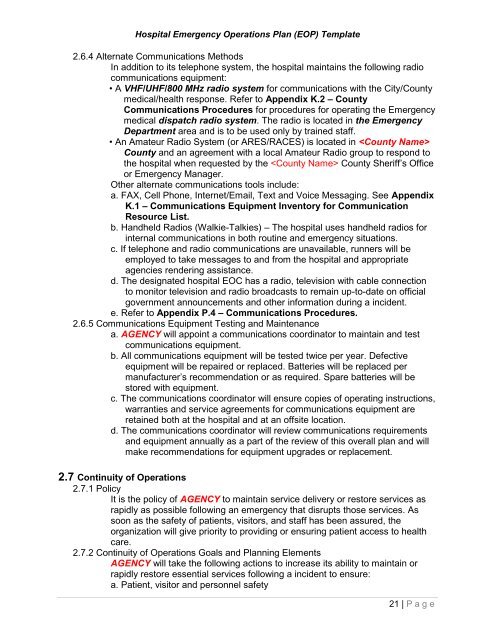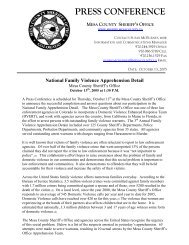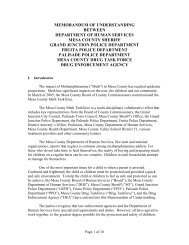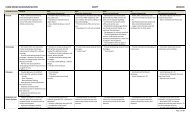Hospital Emergency Operations Plan (EOP) TEMPLATE
Hospital Emergency Operations Plan (EOP) TEMPLATE
Hospital Emergency Operations Plan (EOP) TEMPLATE
Create successful ePaper yourself
Turn your PDF publications into a flip-book with our unique Google optimized e-Paper software.
<strong>Hospital</strong> <strong>Emergency</strong> <strong>Operations</strong> <strong>Plan</strong> (<strong>EOP</strong>) Template<br />
2.6.4 Alternate Communications Methods<br />
In addition to its telephone system, the hospital maintains the following radio<br />
communications equipment:<br />
• A VHF/UHF/800 MHz radio system for communications with the City/County<br />
medical/health response. Refer to Appendix K.2 – County<br />
Communications Procedures for procedures for operating the <strong>Emergency</strong><br />
medical dispatch radio system. The radio is located in the <strong>Emergency</strong><br />
Department area and is to be used only by trained staff.<br />
• An Amateur Radio System (or ARES/RACES) is located in <br />
County and an agreement with a local Amateur Radio group to respond to<br />
the hospital when requested by the County Sheriff’s Office<br />
or <strong>Emergency</strong> Manager.<br />
Other alternate communications tools include:<br />
a. FAX, Cell Phone, Internet/Email, Text and Voice Messaging. See Appendix<br />
K.1 – Communications Equipment Inventory for Communication<br />
Resource List.<br />
b. Handheld Radios (Walkie-Talkies) – The hospital uses handheld radios for<br />
internal communications in both routine and emergency situations.<br />
c. If telephone and radio communications are unavailable, runners will be<br />
employed to take messages to and from the hospital and appropriate<br />
agencies rendering assistance.<br />
d. The designated hospital EOC has a radio, television with cable connection<br />
to monitor television and radio broadcasts to remain up-to-date on official<br />
government announcements and other information during a incident.<br />
e. Refer to Appendix P.4 – Communications Procedures.<br />
2.6.5 Communications Equipment Testing and Maintenance<br />
a. AGENCY will appoint a communications coordinator to maintain and test<br />
communications equipment.<br />
b. All communications equipment will be tested twice per year. Defective<br />
equipment will be repaired or replaced. Batteries will be replaced per<br />
manufacturer’s recommendation or as required. Spare batteries will be<br />
stored with equipment.<br />
c. The communications coordinator will ensure copies of operating instructions,<br />
warranties and service agreements for communications equipment are<br />
retained both at the hospital and at an offsite location.<br />
d. The communications coordinator will review communications requirements<br />
and equipment annually as a part of the review of this overall plan and will<br />
make recommendations for equipment upgrades or replacement.<br />
2.7 Continuity of <strong>Operations</strong><br />
2.7.1 Policy<br />
It is the policy of AGENCY to maintain service delivery or restore services as<br />
rapidly as possible following an emergency that disrupts those services. As<br />
soon as the safety of patients, visitors, and staff has been assured, the<br />
organization will give priority to providing or ensuring patient access to health<br />
care.<br />
2.7.2 Continuity of <strong>Operations</strong> Goals and <strong>Plan</strong>ning Elements<br />
AGENCY will take the following actions to increase its ability to maintain or<br />
rapidly restore essential services following a incident to ensure:<br />
a. Patient, visitor and personnel safety<br />
21 | P a g e













